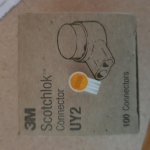yourmomm
Well-Known Member
I've never seen them before, but then I'm no electrician.
You just insert the two wires into the connector, (insulation and all), push the button on top down, and it operates a guillotine, which at once cuts and connects both wires inside the connector, all encompassed by conducting gel of some sort (vaseline or some such, which should keep the salt and moisture out). Then seal the whole lot with self amalgamating coax seal or similar, and those pesky unreliable tiny soldered raymarine radar wires can be cut and rejoined without difficulty...
Seems to work, for now. But for how long? Has anyone else used these with any success in a marine environment?
You just insert the two wires into the connector, (insulation and all), push the button on top down, and it operates a guillotine, which at once cuts and connects both wires inside the connector, all encompassed by conducting gel of some sort (vaseline or some such, which should keep the salt and moisture out). Then seal the whole lot with self amalgamating coax seal or similar, and those pesky unreliable tiny soldered raymarine radar wires can be cut and rejoined without difficulty...
Seems to work, for now. But for how long? Has anyone else used these with any success in a marine environment?

